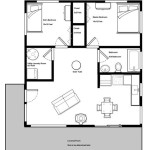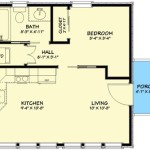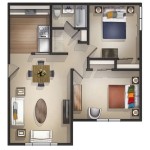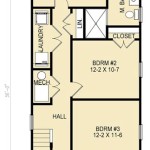```html
The Enduring Appeal of One-Story Closed Floor Plans
One-story closed floor plans, a traditional design approach in residential architecture, continue to hold appeal for a variety of homeowners despite the rising popularity of open-concept layouts. This architectural style emphasizes distinct rooms with clearly defined functions, creating a sense of privacy, separation, and order within the home. Understanding the characteristics, advantages, and potential drawbacks of this design is crucial for individuals considering building or purchasing a one-story home.
A closed floor plan is characterized by individual rooms enclosed by walls and doors. The kitchen, living room, dining room, bedrooms, and bathrooms are all separate spaces. This contrasts sharply with open floor plans, where large spaces are shared between multiple functions, such as the kitchen, dining area, and living room blending into one expansive area. The strategic arrangement of these individual rooms within a single-story structure is what defines the functionality and livability of the house.
The layout of a one-story closed floor plan typically involves a linear or clustered arrangement of rooms. In a linear design, rooms might be aligned along a hallway, with bedrooms concentrated in one section and living spaces in another. A clustered arrangement may feature rooms radiating from a central point or foyer, offering increased separation and potentially more natural light exposure for each room. The specific configuration depends on the size of the house, the shape of the lot, and the homeowner's individual preferences and needs.
Privacy and Sound Control
One of the primary benefits of a one-story closed floor plan is the enhanced privacy it offers. With physical walls and doors separating each room, family members can engage in different activities without disturbing one another. This is especially advantageous for families with children, individuals working from home, or those who value personal space. The division of space creates distinct zones, allowing occupants to pursue hobbies, work, or relax without constant distractions from other household activities.
The inherent soundproofing capabilities of walls and doors significantly reduce noise transmission between rooms. This is a considerable advantage compared to open floor plans, where sound can easily travel across large, connected areas. For example, someone watching television in the living room will not be as likely to disturb someone sleeping in a bedroom in a closed floor plan. This sound isolation is critical for creating a comfortable and peaceful living environment, particularly in homes where different family members maintain varied schedules or require periods of quiet concentration.
Furthermore, closed floor plans allow for more effective temperature control in individual rooms. With walls and doors acting as barriers, it is easier to heat or cool specific areas of the house, leading to potential energy savings. Heating or cooling a bedroom only when it is occupied, for example, is more efficient in a closed floor plan compared to a large, open space where the entire area must be conditioned. This targeted temperature control contributes to a more comfortable and energy-efficient home environment.
Defined Functionality and Organization
Closed floor plans promote a sense of order and organization by clearly defining the purpose of each room. Each space is specifically designed and furnished to support its intended function, whether it's cooking in the kitchen, dining in the dining room, relaxing in the living room, or sleeping in the bedroom. This dedicated space allocation facilitates efficient use of space and helps to maintain a tidy and organized home.
The separation of rooms allows for more focused activities and reduces the likelihood of overlapping functions. For instance, a dedicated home office in a closed floor plan provides a distraction-free environment for work, while a separate dining room fosters a more formal and intimate dining experience. This dedicated functionality contributes to increased productivity, enjoyment, and overall well-being within the home.
Moreover, closed floor plans provide more opportunities for customized design and decoration in each room. Homeowners can tailor the style, colors, and furnishings of each room to reflect their personal preferences and the specific function of the space. This allows for a more personalized and cohesive aesthetic throughout the house, with each room serving as a distinct expression of individual style and taste. The ability to control the visual and functional elements of each room leads to a more tailored and satisfying living experience.
Considerations and Potential Drawbacks
Despite their advantages, one-story closed floor plans also present certain considerations. The separation of rooms can sometimes lead to a feeling of confinement or isolation, especially in smaller homes. The limited flow between spaces may not be ideal for those who prefer a more social and connected living environment.
Remodeling or renovating a closed floor plan can be more challenging and costly compared to open floor plans. Removing walls to create larger, more open spaces may require structural modifications and careful consideration of load-bearing walls. This can significantly increase the time, expense, and complexity of renovation projects. Therefore, homeowners should carefully consider their long-term needs and preferences before committing to a closed floor plan.
The design of a one-story closed floor plan requires careful attention to space planning and circulation. Narrow hallways and small, isolated rooms can feel cramped and undesirable. Effective space utilization and strategic placement of windows and doors are crucial for maximizing natural light and creating a sense of spaciousness within each room. Professional architectural design assistance can be invaluable in optimizing the layout and functionality of a one-story closed floor plan to mitigate these potential drawbacks.
Furthermore, reselling a home with a closed floor plan in a market trending towards open-concept designs might present a challenge. While some buyers specifically seek the privacy and structure offered by closed floor plans, others may prefer the more modern and spacious feel of open layouts. Understanding the local market preferences and potential buyer demographics is important when considering the long-term investment value of a one-story home with a closed floor plan.
Ultimately, the decision to choose a one-story closed floor plan depends on individual priorities and lifestyle. While open floor plans have gained considerable popularity, the traditional appeal of closed floor plans, with their defined spaces and inherent privacy, endures for those seeking separation and order within their living environment. Careful consideration of the advantages and drawbacks, along with thoughtful planning and design, is essential for creating a comfortable and functional home that meets the specific needs of its occupants. The continuing relevance of this architectural style underscores its inherent value in providing a distinct and livable residential option.
```
Traditional Homes With Closed Floor Plans Blog Eplans Com

Traditional Homes With Closed Floor Plans Blog Eplans Com

Traditional Homes With Closed Floor Plans Blog Eplans Com

Unique One Story House Plans Monster

We Re Making A Case For The Not So Open Floor Plans

Traditional Homes With Closed Floor Plans Blog Eplans Com

One Story Farmhouse Plan With Closed Foyer 1367 Sq Ft 801102pm Architectural Designs House Plans

Small One Story 2 Bedroom Retirement House Plans Houseplans Blog Com

40 X 55 2 200 Sf One Story House Plan Elevations The Escape

Must Have One Story Open Floor Plans Blog Eplans Com








